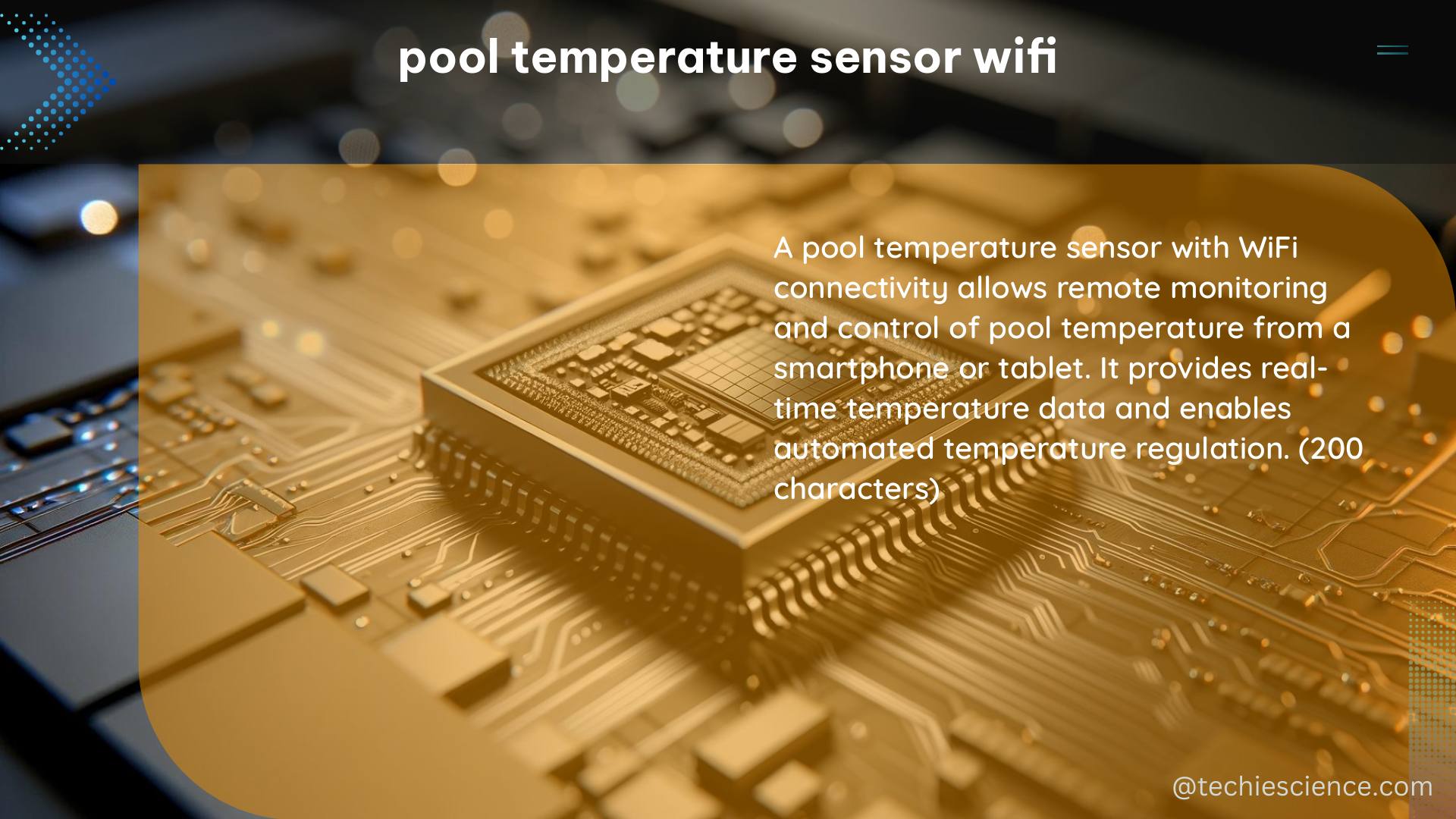The pool temperature sensor WiFi is a versatile device that allows you to monitor the temperature of your swimming pool or any other body of water remotely. These sensors are designed to be waterproof and can be placed directly in the pool or near it, providing accurate temperature readings that can be transmitted wirelessly to a receiver or a connected system.
Understanding Pool Temperature Sensor WiFi Devices
Pool temperature sensor WiFi devices typically consist of two main components: an outdoor thermometer and an indoor receiver. The outdoor thermometer is the waterproof unit that is placed in the pool or near it, while the indoor receiver displays the temperature readings and can be placed inside your home or a designated monitoring area.
One popular example of a pool temperature sensor WiFi is the INKBIRD IBS-P01R 2 Wireless Pool Thermometers. This set includes two outdoor thermometers and one indoor receiver. The outdoor thermometers can measure temperatures ranging from -40°C to 70°C (-40°F to 158°F) with a temperature sampling period of 10 seconds. The indoor receiver can display the temperature readings from both outdoor units and has a transmission frequency of 433MHz with a transmission distance of up to 300 feet in open space.
Another example is the TFA pool temperature sensor, which can be recognized as WT0124/WT0122 using the rtl_433 protocol. This sensor can be integrated into home automation systems like OpenHAB and can send temperature readings using MQTT.
Technical Specifications and Features

Pool temperature sensor WiFi devices come with a variety of technical specifications and features that cater to different needs and preferences. Here’s a closer look at some of the key aspects:
Communication Protocols
- Z-Wave: Some pool temperature sensor WiFi devices use the Z-Wave protocol, which is a low-power wireless communication standard designed for home automation. This allows for seamless integration with Z-Wave-compatible smart home systems.
- MQTT: The MQTT (Message Queuing Telemetry Transport) protocol is a lightweight, publish-subscribe network protocol that is commonly used for IoT (Internet of Things) applications. Pool temperature sensors like the TFA can transmit data using MQTT.
- rtl_433: The rtl_433 protocol is a software-defined radio (SDR) tool that can be used to decode and receive data from various wireless devices, including the TFA pool temperature sensor.
Waterproof Levels
- IPX7: The INKBIRD IBS-P01R outdoor thermometers have a waterproof rating of IPX7, which means they can withstand temporary immersion in water up to 1 meter (3.3 feet) for up to 30 minutes.
- IPX8: Some pool temperature sensor WiFi devices may have an even higher waterproof rating of IPX8, which allows for continuous submersion in water.
Transmission Frequency and Distance
- 433MHz: The INKBIRD IBS-P01R has a transmission frequency of 433MHz, which is a common frequency used for wireless communication in home automation and IoT applications.
- 300 feet: The INKBIRD IBS-P01R has a transmission distance of up to 300 feet in open space, allowing for a wide range of coverage.
Power Source
- Battery-powered: Many pool temperature sensor WiFi devices are powered by batteries, such as the INKBIRD IBS-P01R, which uses 2 AAA batteries for the outdoor thermometers and 4 AAA batteries for the indoor receiver.
- Solar-powered: Some pool temperature sensor WiFi devices, like the one mentioned in the Reddit post, can be integrated with a solar solution for a more energy-efficient and eco-friendly power source.
DIY Pool Temperature Sensor WiFi Projects
For DIY enthusiasts, there are several ways to build a pool temperature sensor WiFi device using various components and communication protocols. One example is a project that uses a Wemos D1 mini and a 50mm DS18B20 temperature probe.
The process involves:
1. Cutting the plumbing after the return pump and inserting a T socket with thread.
2. Installing the temperature probe in the T socket.
3. Connecting the probe to the Wemos D1 mini.
4. Configuring the Wemos to send temperature readings using MQTT.
This DIY solution allows for a wireless and customizable pool temperature monitoring system that can be integrated with home automation platforms like OpenHAB or Home Assistant.
Conclusion
Pool temperature sensor WiFi devices are essential tools for monitoring the temperature of swimming pools and other bodies of water. These sensors come in various forms, with different communication protocols, waterproof levels, transmission frequencies, and power sources. DIY enthusiasts can also build their own pool temperature sensor WiFi devices using a variety of components and communication protocols, allowing for a more personalized and customizable solution.
References:
– How to measure outside Pool Temperature? Battery driven and wireless. (2020, July 18). Retrieved from https://community.openhab.org/t/how-to-measure-outside-pool-temperature-battery-driven-and-wireless/102501/21
– INKBIRD IBS-P01R 2 Wireless Pool Thermometers with Wireless Receiver Set Floating Easy Read, Remote Pool Thermometer for Swimming Pool, Bath Water, and Hot Tubs 2nd Updated Generation – Amazon.com. (n.d.). Retrieved from https://www.amazon.com/INKBIRD-Pool-Thermometer-Combo-Series/dp/B0CQYK35HB
– WIFI Pool Temperature Monitor – Part 1 – YouTube. (2016, June 3). Retrieved from https://www.youtube.com/watch?v=oie5x_4PKc8
– The First Solar Powered WiFi Pool Thermometer – Reddit. (2021, May 13). Retrieved from https://www.reddit.com/r/homeassistant/comments/nbpjbr/the_first_solar_powered_wifi_pool_thermometer/
– Raspberry Pi Project: Wireless Pool Temperature Sensor – Raspberry Pi Forums. (2015, August 10). Retrieved from https://forums.raspberrypi.com/viewtopic.php?t=117812

The lambdageeks.com Core SME Team is a group of experienced subject matter experts from diverse scientific and technical fields including Physics, Chemistry, Technology,Electronics & Electrical Engineering, Automotive, Mechanical Engineering. Our team collaborates to create high-quality, well-researched articles on a wide range of science and technology topics for the lambdageeks.com website.
All Our Senior SME are having more than 7 Years of experience in the respective fields . They are either Working Industry Professionals or assocaited With different Universities. Refer Our Authors Page to get to know About our Core SMEs.